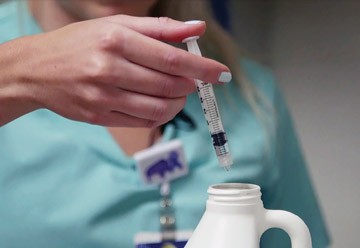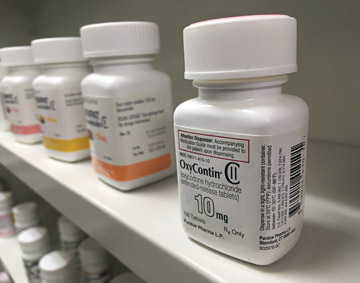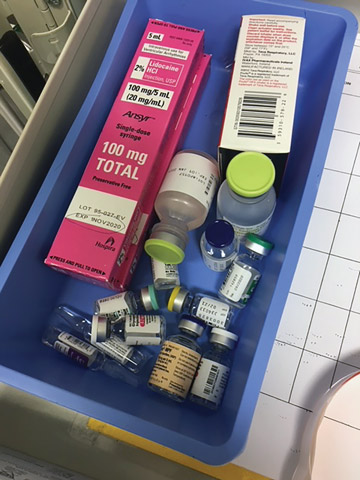4. A patient claims to be allergic to sulfa medications, which have caused him to suffer major body rashes. Is it necessary to alert anesthesia of the reported allergy to sulfas because some forms of propofol contain sulfites?
- a. yes
- b. no
- Reveal
Answer: b
Sulfa drugs treat a variety of health conditions, including common infections, while sulfites are preservatives used in foods, drinks (especially wine) and medications. "Sulfa drugs and sulfites are not
related," explains Mr. Sones. "Neither are their allergies, so there is no need to worry about administering propofol to a patient who is allergic to sulfas."
Close
5. How much dantrolene is needed to treat malignant hyperthermia in a patient weighing 70 kg?
- a. 500 mg
- b. 600 mg
- c. 700 mg
- Reveal
Answer: c
An initial dose of dantrolene at 2.5 mg/kg is recommended, with a suggested upper limit of 10 mg/kg. If the patient weighs 70 kg, at least 700 mg is needed. Dantrium and Revonto, two dantrolene products,
come packaged in 20 mg vials. Each vial should be reconstituted for injection by adding 60 ml of sterile water and shaken until the solution is clear. Ryanodex, a third dantrolene option, is packaged in 250 mg vials. It must
be reconstituted with 5 ml of sterile water and shaken into an orange-colored opaque suspension. In order to have enough dantrolene on hand to administer the initial dose, you must stock 30 vials of Revonto and Dantrium, and
three vials of Ryanodex.
Close
6. Which two medications are used to treat glaucoma and anxiety, respectively?
- a. acetohexamide
- b. acetazolamide
- c. hydralazine
- d. hydroxyzine
- Reveal
Answer: b & d
Acetazolamide is the generic form of Diamox. It's a sulfur-containing product that is used to relieve intraocular pressure caused by glaucoma. Acetohexamide is the generic form of Dymelor, an older
antidiabetic drug. Hydroxyzine is the generic version of Vistaril or Atarax and can be used to address anxiety. It can also be used to treat nausea and itching. Hydralazine is an antihypertensive, with a trade name of Apresoline.
These drugs have very different uses but are easily confused because they have similar sounding names. When handling Look Alike/Sound Alike (LASA) medications, be sure to separate them in drug storage areas. If their labels
are handwritten, use tall man lettering — writing part of a drug's name in capital letters — to differentiate it from similar-looking drugs. When using pre-printed labels, color-code drugs based on their classifications
to help avoid confusion during administration.
Keep in mind that guidelines issued by the American Society of Anesthesiologists say all labels on vials and ampoules must contain the drug's generic name, concentration,
total volume or contents, manufacturer, lot number, date of manufacturing and expiration date. Additionally, providers must note the drug, strength, date and their initials on labels affixed to syringes that will be used in
the OR.
Close
7. A patient indicates a "significant allergy" to Percocet on an admission report. The PRN list for pain management lists several drugs and looks like the example below (the checkmarks indicate the prescriber's endorsed orders). What's your next step?
- If the patient cannot take Percocet, administer fentanyl 50 mcg x1; may repeat in 15 minutes one time only
- Oxycodone with APAP x1 as needed one time only
- Tramadol 50 mg PRN for pain
- Acetaminophen with Codeine #3 PRN for pain
- Dilaudid 2 mg PO x1 if oxycodone/APAP is ineffective
- Reveal
Call the prescriber.
Oxycodone with APAP is Percocet. If a patient is allergic to Percocet, then oxycodone with APAP is the same thing. "This example reaffirms the need to correlate stated allergies and side effect
declarations to endorsed medication orders," says Mr. Sones.
Close
.svg?sfvrsn=be606e78_3)



.svg?sfvrsn=56b2f850_5)